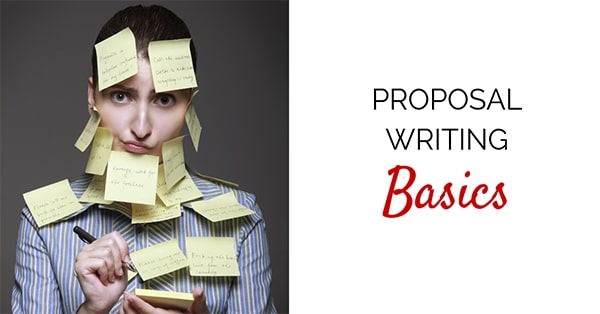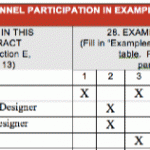
Whether it’s a business, project, or a different type of proposal, the goal is the same: to convince the reader to make the choice you propose. Therefore, your proposal has to be persuasive. In this post, I won’t just cover how to write a proposal. I’ll tell you how to write a good proposal.
How To Write A Good Proposal
The first thing you need to keep in mind that all communication, including writing, is persuasion. The words you write will be delivered to your audience. This may even be a potential client or teaming partner. The goal of these words is to influence that person’s decisions.
It’s that simple. Before you start writing the proposal, it is important to understand a few things about the reader:
- He/she cares first and foremost about their own needs.
- He/she will want to spend as little time as possible reading or looking at your proposal.
With this in mind, there are a few established rules of thumb when writing proposals:
- Tell them, tell them, and tell them some more
- Proposals are not about you
- Sell the benefit.
- Be extremely specific
- Keep it as brief, but not briefer, than possible.
- Spoon feed the reader.
- Focus on the action.
Tell Them, Tell Them, and Tell Them Again
There is an old saying that goes with proposal and presentation development.
- Tell them what you’ll tell them.
- Tell them.
- Tell them what you told them.
This is good advice. Believe it or not, repetition is good. If you say something to someone twenty times, they’ll complain you told them twice. If you say it once, it’s likely they’ll forget you said it.
Proposals Are Not About You, They’re About Them
When writing proposals, people forget the golden rule: do unto others as you would have them do upon you. You probably hate people who only talk about themselves. So, why would you be that person? I understand that you want to give the client a 10-page description of how amazing you or your firm are.
But frankly, people these days don’t have the time or interest to read ten pages about you. Write about them and how they can benefit from your resources, experience, and approach. Throughout the process of writing this proposal, keep reminding yourself, “It’s not about me.”
Sell the Benefit
“Sell the Benefit” is a pretty simple concept. Your words need to tell the reader how the choice you are advocating will benefit them. The reader needs to gain a clear understanding of what he or she would gain from making the choices you promote.
Often, proposal writers fall into the trap of talking about how great their firm is and forgetting to identify how it impacts or intersects with the reader. Readers tend to hate this “fluff” and will most likely skim or skip it completely.
A great way to make sure your writing “sells the benefit” is to use the “So What? Test.”
The “So What?” Test
As I said, the most effective measurement of benefit selling is the “so what?” test. Here’s a video explaining how it works.
After you write something, go back and read it pretending you are the intended audience. Picture yourself as that grumpy old man who used to steal your baseball if it accidentally landed in his yard.
After reading each paragraph, ask yourself “so what?” Let’s apply this test to some examples?
Example:
Our firm has been in business for 50 years.
So What Test Result: Fail
Example:
Using the lessons learned from 50 years of experience designing high-rise buildings, we will ensure your design is technically correct, constructible, and cost-effective.
So What Test Result: Pass
Example:
We started with only three people and now employ over 100 employees.
So What Test Result: Fail
Example:
With 100 qualified employees, we have the in-house resources to meet your current expectations and satisfy any changing needs.
So What Test Result: Pass
Let’s give some real-life examples of the test in action. Here are two redacted write-ups found on the websites of large mechanical/electrical/plumbing design firms.
How do these examples compare against the “so what” test?
Example #1:
ABC Engineers is a leading consulting engineering firm providing technical leadership, experience in design and quality service across all market sectors worldwide. In addition to our core mechanical and electrical design services, we provide additional consulting services to better serve our clients.
Example #2:
Business challenges often have solutions in technology, facilities, and processes. We understand what drives your business. Moreover, we take a partner’s interest in your success. It is our belief that partners give partners a competitive edge. Our clients depend on us to bring an outsider’s perspective and analytical ability to help them plan, phase, and reach their goals. Our ability to engineer, construct, and operate facilities rounds out that objective.
If you said example #2 passes the test and example #1 fails the test, you are right.
Can you see the difference between these two paragraphs? Can you see how one speaks to you and the other speaks at you.
Example #1 is not bad writing. It just does not “sell the benefit.” Therefore, it is not persuasive.
Be Extremely Specific
Writing a proposal is like being on The Dating Game. You have to convince the client that you’re the best choice. You can’t do this with vague, weasel words. Let’s pretend you are on the dating game and the girl behind the wall asks:
“I’m one of the most sought after girls in the city. Where should a guy take me on our first date?”
Well, you could say:
“Your date should take you to a really nice restaurant and then maybe out dancing.”
That’s a reasonable answer, but you’ll be going home alone after the show. It’s better to say:
“I take all my dates to Victor’s, a little-known Italian restaurant where we can enjoy a romantic candlelit dinner. As the waiters serve your food, they’ll sing you beautiful arias that will warm your soul.” “Then I’ll take you dancing at the most exclusive club in the city, Studio 56, where we can relax in the VIP lounge or dance the night away.”
Honestly, these answers both suggest dinner and dancing. But which one is more persuasive? You guessed it, the second one because it’s extremely specific.
And that’s what you have to do with proposal writing, be extremely specific. Tell them exactly what you are going to do for them.
Keep it as Brief, But Not Briefer, than Possible
Many proposal writers are under the delusion that people enjoy reading their long-winded proposals. They will write a flowery four-page cover letter and expect a potential client to read it.
However, if I sent them a four-page marketing letter about my marketing supply business, most of them would not read it. This is why it is important to keep it brief, because no one wants to spend his or her time reading your drivel.
On the other hand, some proposal managers keep it too brief. Too brief is when you don’t sufficiently cover the benefits or address the audience’s requirements.
People don’t like to read content that is too long, but they are suspicious of content that it too short. It screams, “This firm isn’t the best choice.”
How to Keep it Brief
Especially with proposals, clients will often ask for a large amount of information. So, how do you satisfy their expectations without writing the next War and Peace?
Here are some tools you can use to help you keep it brief.
- Bullet Lists
- Graphs and Charts
- Pictures
- Delete Needless Words
Bullet Lists
By using bullet lists, you can often take large paragraphs and break them down in a more readable fashion. Bullet lists are easier for readers to absorb and it’s more likely that they will take the time to read a bullet list. You can often convey the same information but in bullet list format. Furthermore, important points or summaries often benefit from the use of bullet lists.
Why use bullet lists?
• Easier for reader to absorb.
• Conveys same information with fewer words.
• Helps emphasize important points.
Charts and Graphs
Many firms use charts and graphs to help convey a complicated process, concept, or method that would otherwise take many words. It is always good practice to use charts and graphs, as much as possible, to present marketing information.
Pictures
Some say that a “picture is worth a thousand words.” And for the most part, that is true. If you can convey an idea or demonstrate a fact with a picture, do it. Using pictures in the right way can give the reader a break and help keep their attention. Just make sure they are relevant.
Delete Needless Words
Re-read your writing and try to find sentences that can be shortened by removing useless words. Concise writing does not contain unnecessary words.
Every word should be essential to the sentence. Every word should earn its place on the page.
For example:
Due to the fact that our firm has designed twenty similar structures, we are eminently more qualified to design your project. (20 Words)
This sentence can be shortened to:
Because we designed twenty similar structures, we are the most qualified choice. (11 Words)
Spoonfeed the Reader
We live in a world where people want their information easily and quickly. Some proposal writers make the mistake of forcing a reader to figure things out for themselves.
That’s not a great idea. You don’t want the reader to have to decipher your message.
Writing proposals is not like writing a novel. Proposals needs to be direct and lead the reader to an obvious conclusion. Be sure to directly state the conclusion within your content. Make it easy for the reader to follow your writing.
Use subheads, follow formats exactly as clients have laid out, and above all don’t “beat around the bush.” In addition, we have the disadvantage of knowledge.
We just assume that everybody knows the good and bad things about our firm. That’s a terrible assumption. Here is a better one to use. Assume the reader knows nothing.
If you don’t explicitly tell them, they don’t know it. Don’t talk down to the reader, but assume they are starting from a blank slate.
Focus on the Action
There has been a good deal written about the use of active voice in writing. I recommend that you write in the active voice. In the active voice, the subject of the sentence is performing the action. Sentences that are written in the passive voice read weak and sound less important.
Passive Voice:
The MEP systems were designed by our firm.
Active Voice:
Our firm designed the MEP systems.
To make proposal content read strong, it is important to focus on the action. By focusing on the action, we describe exactly what action occurred. Let’s look at an example:
Mark assisted Pamona County with inspection during the $365M reconstruction on Pamona Bridge, in Audibon, NJ.
While it’s true that Mark was performing the inspection services for Pamona County, when you read this sentence, Mark seems like a secondary player in our story. But Mark is really our hero. Here is how this would read if we focus on the action:
Mark inspected the general contractor’s work during the $365M reconstruction of Pamona Bridge, in Audibon, NJ.
In this sentence, we learn exactly what Mark was doing. Mark inspected the general contractor’s work.
The sentence is now much stronger.
Those are the basics of how to write a good proposal.
Read The Other Sections Of My Ultimate Guide To Proposal Writing
The article you just read is one section of my Ultimate Guide To Proposal Writing.
Click on the links below to read the other parts.
- Part One: Proposal Writing Basics
- Part Two: The Proposal Structure
- Part Three: The Proposal Writing Formula
- Part Four: The 3 Golden Rules Of Proposal Design
- Part Five: Proposal Templates: What You Need To Know
- Part Six: Architecture, Engineering, and Construction Proposals: How To Write Them





I am a professional proposal writer in lagos Nigeria and I must confess that you have done a good job on this article. I learnt a few new things. Thanks. Keep up the god work
Its very educative and well explained. Thank you.
I am happy that I am among the lucky ones that read your article. Thank you so much.
Thanks for this teaching it was resourceful